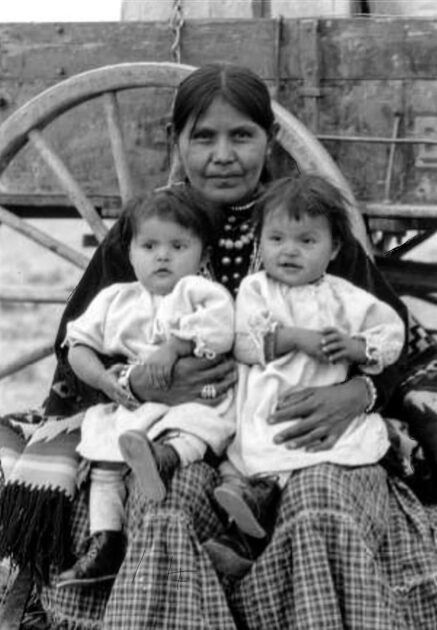Description: A Navajo (Native American) woman poses outside with her twins. Seated next to a wagon.
In the crisp Colorado air of the 1920s, a poignant moment is captured in a photograph: a Navajo woman sits serenely with her twin children by her side, a wagon resting nearby. This image offers a window into the lives of the Navajo people during a time of significant change and adaptation.
The Navajo, or Diné as they call themselves, have a rich cultural heritage rooted in the American Southwest. By the 1920s, many Navajo families found themselves navigating the complex interplay between traditional ways and the encroaching influences of modern American society. This period was marked by both resilience and adaptation as they sought to preserve their identity while integrating new aspects into their daily lives.
The woman in the photograph embodies the strength and grace of the Navajo people. Her traditional attire reflects a deep connection to her cultural roots, while her serene expression speaks to the enduring spirit of her people. The twins, nestled closely, symbolize the continuation of Navajo traditions and the hope for a future that honors their heritage.
The presence of the wagon in the photograph is significant. Wagons were a common sight during this era, used for transportation and the carrying of goods. For the Navajo, they represented a blend of the old and the new. While they maintained many aspects of their traditional way of life, they also adopted practical tools and methods that could help them thrive in a changing world.
Life in Colorado for the Navajo was shaped by the broader context of American history at the time. The 1920s were a decade of transition, with the United States experiencing economic growth, technological advancements, and cultural shifts. For Native American communities, this period also brought challenges, including pressures to assimilate and the ongoing impact of government policies aimed at altering their traditional lifestyles.
Despite these challenges, the Navajo people remained resilient. They adapted to new circumstances while fiercely protecting their cultural heritage. This duality is evident in the photograph: a mother nurturing her children in a landscape that holds both the promise of new opportunities and the steadfastness of tradition.
The twins, growing up in this dynamic environment, would have been taught the values and stories of their ancestors. They would have learned to navigate a world that was constantly evolving, finding strength in their heritage while embracing the changes around them.
The photograph also underscores the importance of family and community within Navajo culture. The woman’s role as a mother is central, highlighting the matrilineal nature of Navajo society where lineage and inheritance are traced through the mother’s line. This matriarchal structure underscores the vital role women play in maintaining cultural continuity and nurturing the next generation.
As we look at this image today, it serves as a reminder of the Navajo people’s enduring legacy. Their ability to adapt while holding onto their identity is a testament to their strength and resilience. The woman and her twins, seated next to the wagon, offer a timeless snapshot of a community at a crossroads, navigating the path between tradition and change.
In the vast and varied landscape of Colorado, the Navajo people continued to carve out a life that honored their past and embraced their future. This photograph, simple yet profound, captures a moment of quiet dignity and the enduring spirit of a people who have always been, and continue to be, an integral part of the American tapestry.

